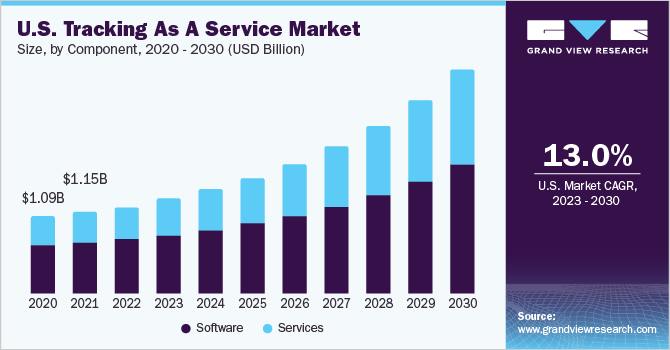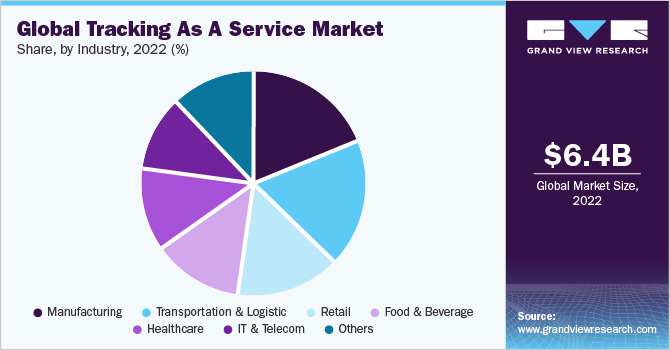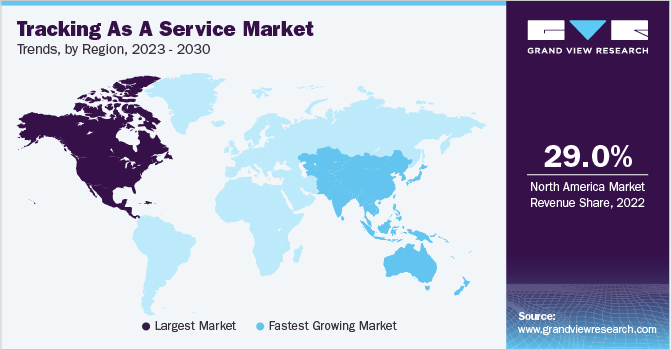- Home
- »
- Communication Services
- »
-
Tracking As A Service Market Size And Share Report, 2030GVR Report cover
![Tracking As A Service Market Size, Share & Trends Report]()
Tracking As A Service Market Size, Share & Trends Analysis Report By Component, By Enterprise Size, By Asset Type, By Industry, By Region, And Segment Forecasts, 2023 - 2030
- Report ID: GVR-4-68040-117-4
- Number of Report Pages: 140
- Format: PDF, Horizon Databook
- Historical Range: 2017 - 2021
- Forecast Period: 2023 - 2030
- Industry: Technology
Report Overview
The global tracking as a service market size was estimated at USD 6.42 billion in 2022 and is expected to grow at a compound annual growth rate (CAGR) of 17.1% from 2023 to 2030. The demand for real-time monitoring, data-driven insights, and improved operational efficiency across diverse industries such as logistics, transportation, healthcare, and supply chain management has significantly driven the market growth. This growth is underpinned by advancements in sensor technologies, Internet of Things (IoT) connectivity, and cloud computing, which have collectively facilitated the development of seamless and cost-effective tracking solutions. This technological advancement empowers enterprises to achieve exceptional precision in tracking assets, vehicles, shipments, and personnel, reducing risk, optimizing resource utilization, and lowering operational expenditures.

The growing emphasis on data-driven decision-making is another major factor driving the adoption of tracking solutions, as businesses recognize the value of real-time insights in gaining a competitive edge. The rise in digitalization across various industries, such as logistics, is expected to bode well for the market's growth. For instance, in June 2022, Accenture interviewed 14 industry experts and surveyed over 600 logistics executives to assess the industry's digital maturity. The survey revealed that leaders invest 2.5 times more than laggards in digitalization to achieve more digital maturity than low-spending peers.
The continuous evolution of 5G networks holds the potential to amplify the functionalities of tracking systems, ushering in elevated data transfer speeds, reduced latency, and heightened connectivity reliability. For instance, global internet penetration has reached 59.6% of the total global population in 2021. Furthermore, the extension of tracking-as-a-service into emerging domains like smart cities, environmental surveillance, and precise agriculture introduces fresh avenues for growth. Consequently, these elements are contributing to the growing acceptance of tracking-as-a-service across diverse industries on a global scale.
The growth of tracking-as-a-service worldwide can be attributed to the rising acquisitions and mergers and increased investment in the logistics sector. For instance, in December 2022, Trimble, Inc., a tracking-as-a-service provider, announced that it raised USD 1 billion as a debt from Bank of America Corp. As a result of these fund-raising initiatives, the company aimed at acquiring Germany-based Transporeon, a cloud-based transportation management software platform. Furthermore, the increasing strategic initiatives such as partnerships and collaboration between the market players also bode well for the market's growth over the forecast period.
While the tracking-as-a-service market is poised for growth over the forecast period, it does face certain challenges. These obstacles involve data security and privacy concerns, particularly transport and logistics data. This highlights the importance of enforcing rigorous security protocols and adhering to regulatory guidelines. However, the t market is primed for growth as enterprises grasp the concrete advantages of real-time tracking in streamlining operations, trimming expenses, and ultimately providing enriched customer experiences.
COVID-19 Impact Analysis
The outbreak of the COVID-19 pandemic had a slight negative impact on the tracking-as-a-service market. Lockdowns and global logistics challenges resulted in disruption in the logistics industry. The supply chain was disrupted due to the restrictions on the import and export of goods, which led to the negative growth of the market. However, post the COVID-19 pandemic, the shifting consumer behaviors and disruptions in supply chains resulted in the increased demand for real-time tracking solutions. The pandemic expedited digital transformations, accelerating the adoption of tracking-as-a-service to facilitate remote monitoring and informed decision-making, thereby driving the growth of the market over the forecast period.
Component Insights
The software segment dominated the market in 2022 and accounted for a share of more than 61.0% of the global revenue. The growth of the software segment can be attributed to factors such as the rapid advancement of technology, which has led to the development of sophisticated tracking software solutions that offer a wide range of capabilities. These software solutions encompass features such as real-time tracking, data analytics, predictive modeling, and integration with other business systems. Businesses are drawn to these software offerings due to their potential to provide actionable insights, optimize operations, and improve decision-making processes.
The services segment is anticipated to register the fastest growth over the forecast period. Professional and managed services are witnessing growth due to their capacity to provide tailored solutions and implementation support. These services address the intricate needs of businesses by offering customization, seamless integration, and ongoing management of tracking solutions. Outsourcing tracking-related tasks to managed service providers allows businesses to focus on core competencies while staying up-to-date with evolving tracking technologies. These services also encompass risk mitigation, compliance adherence, and scalability, ensuring that tracking systems align with industry standards and accommodate changing business demands.
Enterprise Size Insights
The large enterprises segment dominated the tracking-as-a-service market in 2022 and registered a revenue share of above 65.0%. The growth can be attributed to the increased adoption of tracking-as-a-service software and services for various strategic advantages, such as real-time tracking by large businesses. These solutions offer real-time visibility & control, streamlining operations by optimizing routes, managing risks, and ensuring compliance with regulations. The data-driven insights from tracking systems empower informed decision-making while enhancing the customer experience through transparency and accurate updates.
The small & medium enterprises (SMEs) segment is expected to witness the fastest growth over the forecast period. SMEs are drawn to tracking-as-a-service software and services due to their cost-effectiveness, enabling access to advanced tracking technologies without substantial financial outlays. These solutions also facilitate operational efficiencies and resource optimization, aligning with the agile nature of SMEs. By embracing tracking technologies, SMEs can enhance their competitiveness by meeting customer expectations for real-time updates, improving supply chain visibility, and mitigating risks.
Asset Type Insights
The manufacturing assets segment dominated the market in 2022 and accounted for a revenue share of more than 35.0%. The segment's dominance can be attributed to its pivotal role in addressing key manufacturing needs. These solutions enable manufacturers to optimize resource allocation, minimize downtime through predictive maintenance, and streamline supply chain operations by offering real-time visibility into machinery, equipment, and inventory. The integration of tracking technologies aids manufacturers in adhering to regulatory standards, enhancing data-driven decision-making, and maintaining product quality, which is expected to grow over the forecast period.
The in-transit equipment segment is projected to witness the fastest growth over the forecast period. The growth is ascribed to its pivotal role in meeting the dynamic needs of transportation and logistics-intensive industries. These solutions cater to the demand for real-time visibility into the movement and status of assets such as vehicles, shipments, and containers. Furthermore, tracking-as-a-service solutions empower businesses to optimize supply chain operations, mitigate risks, and ensure regulatory compliance by offering insights into location, conditions, and potential deviations.
Industry Insights
The manufacturing segment dominated the tracking-as-a-service market in 2022 and registered a revenue share of above 19.0%. The segment's growth can be attributed to the real-time visibility into manufacturing assets, from machinery to raw materials, offered by tracking-as-a-service solutions. These solutions empower manufacturers to optimize asset utilization, reduce downtime, and streamline operational efficiency. The integration of tracking technologies facilitates supply chain optimization, enabling end-to-end visibility and informed decision-making. The tracking services help manufacturers maintain optimal inventory levels by monitoring stock quantities, locations, and turnover rates.

The retail segment is expected to grow the fastest over the forecast period. The retail industry is leveraging tracking-as-a-service solutions to enhance operational efficiency and customer experiences. These solutions are pivotal in optimizing inventory management, ensuring timely supply chain deliveries, and improving order fulfillment processes. Real-time tracking empowers retailers to provide accurate updates on order status and estimated delivery times, enhancing transparency and customer satisfaction. Tracking technologies aid in loss prevention by monitoring high-value items within stores, contributing to security measures. Moreover, data collected through tracking systems enables personalized marketing strategies, enabling retailers to offer tailored promotions and recommendations based on individual shopping behaviors.
Regional Insights
North America dominated the tracking-as-a-service market in 2022 and accounted for a revenue share of over 29.0%. The growth can be ascribed to the presence of prominent players such as Rockwell Automation and MicroMain Corporation. A robust technological infrastructure across the region is well-suited for adopting tracking-as-a-service, meeting the demands of real-time tracking and data analytics. The region's focus on data-driven decision-making and technological innovation drives businesses to integrate tracking solutions, enhancing supply chain visibility, customer experiences, and overall operational efficiency in this dynamic and highly competitive landscape.

Asia Pacific is anticipated to grow at the highest CAGR over the forecast period. The regional market's growth can be attributed to the upsurge in e-commerce activities. Thus, the increase in the e-commerce trends in the country has increased the adoption of tracking solutions to track the products for enhancing transparency with customers. In a landscape marked by complex supply chains, manufacturing expertise, and rapid urbanization, tracking-as-a-service solutions streamline logistics, optimize supply chains, and contribute to the sustainability of urban environments.
Key Companies & Market Share Insights
The market for tracking-as-a-service can be considered as being exceptionally competitive and characterized by the presence of various notable industry players. To improve their offers, industry leaders are exploring a variety of methods, including geographic expansions, partnerships & collaborations, and product launches. For instance, in July 2023, Trimble, Inc., a tracking-as-a-service provider, introduced LIMS PRO, a new cloud-hosted version of the Log Inventory and Management System (LIMS). As a result of this launch, the company enabled forest product manufacturing for small and medium-sized companies to realize growth gains and enhance productivity.
Market players are introducing new product offerings. For instance, in June 2021, Midmark RTLS one of the real-time locating system technology providers, introduced a Bluetooth Low Energy (BLE) cloud-based asset tracking solution. As a result of this launch, it provided asset visibility across the health system, tracking assets that move between facilities. Some prominent players in the global tracking as a service market include:
-
Rockwell Automation
-
MicroMain
-
Sortly
-
EZO
-
Finale Inventory
-
Infor
-
Midmark Co.
-
Mojix
-
PCCW Solutions
-
Trimble Inc.
Tracking As A Service Market Report Scope
Report Attribute
Details
Market size value in 2023
USD 7.22 billion
Revenue forecast in 2030
USD 21.80 billion
Growth rate
CAGR of 17.1% from 2023 to 2030
Base year of estimation
2022
Historical data
2017 - 2021
Forecast period
2023 - 2030
Quantitative units
Revenue in USD million/billion and CAGR from 2023 to 2030
Report coverage
Revenue forecast, company market share, competitive landscape, growth factors, and trends
Segments covered
Component, enterprise size, asset type, industry, region
Regional scope
North America; Europe; Asia Pacific; Latin America; MEA
Country scope
U.S.; Canada; Germany; UK; France; China; India; Japan; South Korea; Australia; Brazil; Mexico; Kingdom Of Saudi Arabia (KSA); UAE; South Africa
Key companies profiled
Rockwell Automation; MicroMain; Sortly; EZO; Finale Inventory; Infor; Midmark Co.; Mojix; PCCW Solutions; Trimble Inc.
Customization scope
Free report customization (equivalent to up to 8 analysts working days) with purchase. Addition or alteration to country, regional & segment scope
Pricing and purchase options
Avail customized purchase options to meet your exact research needs. Explore purchase options
Global Tracking As A Service Market Report Segmentation
The report forecasts revenue growth at global, regional, and country levels and analyzes the latest industry trends in each of the sub-segments from 2017 to 2030. For this study, Grand View Research has segmented the tracking as a service market report based on component, enterprise size, asset type, industry, and region:
-
Component Outlook (Revenue, USD Million, 2017 - 2030)
-
Software
-
Services
-
-
Enterprise Size Outlook (Revenue, USD Million, 2017 - 2030)
-
Large Enterprises
-
Small & Medium Enterprises
-
-
Asset Type Outlook (Revenue, USD Million, 2017 - 2030)
-
Electronics & IT Assets
-
In-transit Equipment
-
Manufacturing Assets
-
Others
-
-
Industry Outlook (Revenue, USD Million, 2017 - 2030)
-
Transportation & Logistic
-
Manufacturing
-
Healthcare
-
Food & Beverage
-
Retail
-
IT & Telecom
-
Others
-
-
Regional Outlook (Revenue, USD Million, 2017 - 2030)
-
North America
-
U.S.
-
Canada
-
-
Europe
-
Germany
-
UK
-
France
-
-
Asia Pacific
-
China
-
India
-
Japan
-
South Korea
-
Australia
-
-
Latin America
-
Brazil
-
Mexico
-
-
Middle East & Africa
-
Kingdom Of Saudi Arabia (KSA)
-
UAE
-
South Africa
-
-
Frequently Asked Questions About This Report
b. The global tracking as a service market size was estimated at USD 6.42 billion in 2022 and is expected to reach USD 7.22 billion in 2023.
b. The global tracking as a service market is expected to grow at a compound annual growth rate of 17.1% from 2023 to 2030 to reach USD 21.80 billion by 2030.
b. North America dominated the tracking as a service market with a share of 29.39% in 2022. The regional market growth can be ascribed to the presence of prominent market players such as Rockwell Automation and MicroMain Corporation, among others, which are expected to fuel the market’s growth.
b. Some key players operating in the tracking as a service market include Rockwell Automation; MicroMain; Sortly; EZO; Finale Inventory; Infor; Midmark Co.; Mojix; PCCW Solutions; Trimble Inc.
b. Key factors that are driving the market growth include rising digitalization across the logistics industry and the advantages of tracking-as-a-service.
Share this report with your colleague or friend.
![gvr icn]()
NEED A CUSTOM REPORT?
We can customize every report - free of charge - including purchasing stand-alone sections or country-level reports, as well as offer affordable discounts for start-ups & universities. Contact us now
![Certified Icon]()
We are GDPR and CCPA compliant! Your transaction & personal information is safe and secure. For more details, please read our privacy policy.
We are committed towards customer satisfaction, and quality service.
"The quality of research they have done for us has been excellent."





